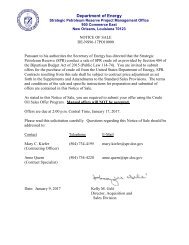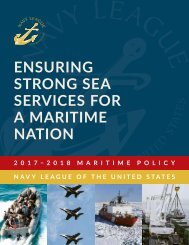2010-11_ANNUAL_REPORTS_-_FINAL_VERSION_(3)
2010-11_ANNUAL_REPORTS_-_FINAL_VERSION_(3)
2010-11_ANNUAL_REPORTS_-_FINAL_VERSION_(3)
You also want an ePaper? Increase the reach of your titles
YUMPU automatically turns print PDFs into web optimized ePapers that Google loves.
Deepwater Horizon<br />
On April 20, <strong>2010</strong>, another disaster called for MARAD assistance, this one man-made. An explosion<br />
sank the British Petroleum-owned Transocean Deepwater Horizon oil rig, killed <strong>11</strong> and injured 17<br />
crewmembers, and led to what is considered the largest accidental marine oil spill in history. In the days<br />
immediately following the explosion, resources were mobilized for what would be, in many ways, an<br />
unprecedented response effort.<br />
Maritime Administration leadership activated the Maritime Command Center (MCC) to participate in<br />
the Interagency Solutions Group (IASG) by monitoring the spill and providing personnel and<br />
information services to the U.S. Coast Guard (USCG) and the National Incident Command (NIC). The<br />
MCC Watch compiled time-critical information received from diverse sources and condensed it into a<br />
standardized format for dissemination and distribution.<br />
Using its maritime expertise, MARAD initially focused on assessing the availability of U.S.-flag vessels<br />
in a timely fashion. Problems multiplied as successive attempts to cap the well failed. On June 16,<br />
<strong>2010</strong>, the Federal On-Scene Coordinator (FOSC) made the determination that until the flow of oil from<br />
the well was stopped, an adequate number of U.S.-flag oil spill response vessels (oil skimmers) could<br />
not be employed in a timely manner to keep up with the pace of the spill. Based on this FOSC<br />
determination, and in response to concerns by some that the Jones Act was hindering British<br />
Petroleum’s ability to obtain skimmer boats in sufficient quantities and in varying types to keep the oil<br />
from spreading to Florida, MARAD facilitated the use of foreign-flag skimming vessels by the USCG<br />
(when no U.S. response vessels were available) by assisting the U.S. Customs and Border Protection<br />
(CBP) in processing Jones Act waiver requests in a timely manner, and in actually locating needed U.S.-<br />
flag assets when they were urgently needed.<br />
The Maritime Administration reviewed the capabilities of oil spill response vessels, and the USCG<br />
emergency rulemaking providing for additional spill response vessels, and was instrumental in<br />
developing a multi-agency Memorandum of Agreement (MOA) on the use of needed foreign-flag<br />
vessels in the spill cleanup process. The MOA with MARAD, USCG, EPA, and DOS expedited<br />
requests for Jones Act exemptions for oil-spill-response vessels that did not already qualify pursuant to<br />
46 U.S.C. §55<strong>11</strong>3. The agreement essentially memorializes the process that these agencies created in<br />
response to the Deepwater Horizon spill, and will continue to expedite allowances for foreign oil-spillresponse<br />
vessels for use in future oil spill events.<br />
Staff from MARAD worked with U.S. Customs and Border Patrol to process Jones Act exemption and<br />
waiver requests in a timely fashion. Seven foreign-flag, non-oil-spill response vessels were allowed to<br />
be used in urgent situations. Total foreign participation in the spill response was limited and estimated<br />
at fewer than 100 foreign-flag vessels. The U.S.-flag merchant marine response to the Deepwater<br />
Horizon disaster was early and extensive. At the center of the response site, known as “spill source<br />
control,” were approximately 38 vessels, including U.S.-flag drill ships, offshore supply vessels,<br />
research vessels, and shuttle tankers.<br />
Following the Deepwater Horizon oil spill, an engineer and a naval architect from MARAD joined an<br />
interagency team to access thousands of proposals for new oil-spill response and clean-up technologies.<br />
34




